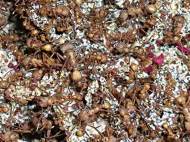New powerful anti-cancer drugs inspired by leaf cutter ants
 Researchers at the University of East Anglia’s School of Biological Sciences are currently developing a new class of anti-cancer drugs that have powerful activity against drug resistant cancer cells. These anti-cancer drugs circumvent a primary cause of resistance to chemotherapy. The study is inspired by leaf cutter ants that belong to the tribe of the fungus-growing ants.
Researchers at the University of East Anglia’s School of Biological Sciences are currently developing a new class of anti-cancer drugs that have powerful activity against drug resistant cancer cells. These anti-cancer drugs circumvent a primary cause of resistance to chemotherapy. The study is inspired by leaf cutter ants that belong to the tribe of the fungus-growing ants.
Leaf cutter ants cut and process fresh vegetation to serve as the nutritional substrate for their fungal cultivars. Besides humans, they form the largest and most complex animal societies on Earth. The ants actively cultivate their fungus, feeding it with freshly cut plant material such as leaves, flowers, and grasses and keeping it free from pests and molds. Leaf cutter ants live in symbiosis with the Streptomyces bacteria that grows on the outer surface of the ants, providing antibiotic protection against disease-causing infection. Among the antibiotics they produce are compounds called antimycins that ants use in their fungi culture, to inhibit pathogenic fungi.
Antimycins act powerfully against drug resistant cancer cells. More than 40 members of the antimycin family of antibiotics are known but the pathway was only recently identified by the research team. They have identified two genetic pathways involved in producing the antibiotic.
“We’re using genetics to understand how the drugs are made in the bacteria so we can tweak the characteristics in favour of anti-cancer action, whilst protecting healthy cells. We want to make Streptomyces into a factory to produce a new type of chemotherapy drug on a large scale”, said Matt Hutchings, professor at UEA.
Some chemotherapeutic drugs cause cancer cells to undergo apoptosis. Resistance to chemotherapy often arises because cancer cells produce proteins that prevent apoptosis. However, antimycins actually inhibit the action of these proteins and allow apoptosis to continue unhindered. What’s more, the harder the cancer cell tries to overcome the chemotherapy, the more effective the drug is.
Antimycins can be very toxic to all cells due to the fact that they interfere with fundamental metabolic process. But, by altering their chemistry it is possible to reduce their harmful characteristics and promote the useful ones. UEA researchers plan to make these changes through genetics so that the anti-cancer drugs can be made cheaply and on a large scale using bacteria in fermentation tanks.









author
If you are interested in how a leaf cutter ant colony looks like and how they cultivate their fungus, the researchers provided two live feeds where you can watch them in action.
Camera 1 represents a live feed video of team’s captive leaf-cutter ant colony. The light is switched on during the day and goes out at night time. Also, the camera is moved when the tanks get cleaned out so if you can’t see anything check the link a bit later.
Camera 2 shows how leaf-cutter ants cultivate their fungus (Currie lab, Wisconsin, USA).
We are turning full circle. Researchers and Scientists are adopting from nature to solve complex problems in a simple way.
Dr.A.Jagadeesh Nellore(AP),India